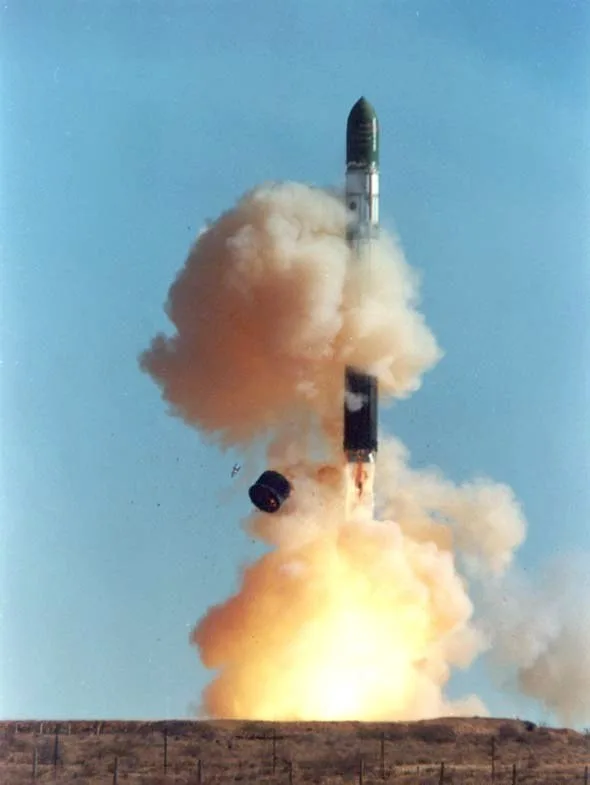ICBMs in Modern Warfare: A New Phase in the Russia-Ukraine Conflict

Ukraine’s military has claimed that Russia launched an intercontinental ballistic missile (ICBM) for the first time during the ongoing conflict. According to Ukrainian air force, the ICBM was launched from the Astrakhan region. This region is located in the south-eastern part of the Russian Federation near the Caspian Sea. Ukraine said the attack targeted enterprises and critical infrastructure in the central-eastern city of Dnipro.
The Ukrainian military reported that six Kh-101 cruise missiles were intercepted, though they did not confirm whether their air defense systems engaged the ICBM. Details regarding casualties or the extent of the damage remain unclear. These claims however are yet to be verified by independent sources.
The launch of an ICBM during a conventional war raises significant questions about the evolving role of strategic missile technology in modern conflicts. Let’s take a detailed look at ICBMs, their development, capabilities, and implications for global security.
What Are Intercontinental Ballistic Missiles (ICBMs)?
ICBMs are long-range missiles designed to deliver payloads—either conventional explosives or nuclear warheads—over thousands of kilometers. These sophisticated weapons can travel at speeds exceeding 24,000 kilometers per hour. This capability enables them to strike targets across continents in less than an hour.
ICBMs are characterized by their multi-stage propulsion systems, guidance technology, and reentry vehicles capable of surviving extreme atmospheric conditions. They are often housed in silos, submarines, or mobile launchers, making them versatile and challenging to neutralize.
Key Features of ICBMs
- Range
ICBMs typically have a range of 5,500 kilometers or more, with some models capable of exceeding 12,000 kilometers. This makes them capable of striking targets across the globe. - Payload
ICBMs can carry a variety of payloads, including:- Conventional Explosives: Rarely used due to their inefficiency compared to other delivery methods.
- Nuclear Warheads: The primary payload, with the potential for massive destruction.
- Multiple Independently Targetable Reentry Vehicles (MIRVs): Advanced ICBMs can deploy several warheads, each targeting a different location.
- Guidance Systems
Modern ICBMs are equipped with sophisticated guidance systems, often involving inertial navigation, GPS, or even AI-assisted targeting. They can make precision strikes. - Delivery Platforms
ICBMs can be launched from various platforms:- Land-Based Silos: Hardened structures designed to protect missiles.
- Submarine-Launched Ballistic Missiles (SLBMs): Ensuring second-strike capability.
- Mobile Launchers: Providing flexibility and reducing vulnerability to preemptive strikes.
History of ICBM Development
ICBMs emerged as a product of Cold War-era competition between the United States and the Soviet Union.
Early Developments
- Germany’s V-2 Rocket (1944): The precursor to modern ICBMs, developed during World War II.
- R-7 Semyorka (1957): The Soviet Union launched the world’s first operational ICBM, marking a pivotal moment in missile technology.
Evolution During the Cold War
- The 1960s saw the introduction of the Minuteman ICBM in the U.S. and the Soviet SS-18 Satan, both capable of carrying multiple warheads.
- Advances in MIRV technology during the 1970s further heightened the strategic stakes.
ICBMs in Modern Warfare
ICBMs are a central element of nuclear deterrence strategies. Nations with operational ICBMs include:
- United States
- Russia
- China
- India
- North Korea
- France
- United Kingdom
- Israel
Pakistan is the only nuclear power that does not have an operational ICBMs so far.
ICBMs are designed to prevent large-scale wars by ensuring a devastating retaliatory capability. However, the use of an ICBM in a conventional conflict, as allegedly seen in the Russia-Ukraine war, marks a significant departure from traditional doctrine.
Scientific Principles Behind ICBMs
1. Propulsion
ICBMs employ multi-stage rocket engines that sequentially detach to maximize efficiency. Solid or liquid fuels are used depending on the missile’s design.
2. Trajectory
ICBMs follow a ballistic trajectory, reaching an altitude of up to 1,200 kilometers before descending towards their target. This path consists of three phases:
- Boost Phase: Initial acceleration using rocket propulsion.
- Midcourse Phase: Coasting through space, often lasting the longest.
- Terminal Phase: Reentry into the Earth’s atmosphere and final targeting.
3. Reentry and Survivability
Reentry vehicles must withstand extreme heat and pressure during atmospheric descent. Ablative coatings and heat shields protect the payload.
Implications for Global Security
The deployment of ICBMs in active conflicts poses significant risks:
- Escalation to Nuclear Conflict: Even a conventional ICBM strike might be misinterpreted as a nuclear attack, prompting retaliatory measures.
- Proliferation: As missile technology spreads, more nations may develop or acquire ICBMs, complicating arms control efforts.
Efforts like the New START Treaty aim to limit the number of deployed nuclear weapons and delivery systems. Russia suspended its participation in the New START treaty on February 21, 2023. Interestingly, despite this suspension, it chose not to withdraw entirely. It claimed it would continue to adhere to the treaty’s numerical limits on nuclear arsenals.
ICBMs epitomize the pinnacle of modern military technology, combining precision, speed, and unparalleled destructive power. The potential use of an ICBM in the Russia-Ukraine conflict marks a significant shift in the weapon’s role. This deployment not only redefines the strategic landscape but also raises urgent questions about the future trajectory of global conflict and arms control, and the looming threat of escalation into a catastrophic World War III.
As Donald Trump prepares to take office, the uncertainty surrounding the Russia-Ukraine war deepens. While Trump has promised a peace deal between the two nations, his unpredictability and controversial track record cast doubt on the sincerity or viability of such a resolution. Simultaneously, Biden, in his final days as president, has amplified U.S. military support for Ukraine, including approving the use of the American-made ATACMS long-range missile system. Ukraine has already employed these systems, reportedly striking targets within Russian territory—a move that possibly provoked Russia to use ICBM.
Could the alleged ICBM launch signify the conflict’s escalation into a more dangerous phase? What does this say about the thin line between conventional and nuclear warfare? And, as geopolitical tensions rise, how can the international community ensure that strategic arms agreements like New START are upheld in an era of increasing distrust?
The deployment of ICBMs in this war poses critical ethical and strategic dilemmas. Have we reached a point where these weapons, once designed solely to prevent wars, are now being used to wage them? If so, what safeguards can the world implement to prevent further escalation or miscalculation? These questions demand urgent attention as the global order faces challenges unseen since the Cold War.
Intermediate-Range Ballistic Missile (IRBM) Escalation
Amid growing reports of Russia’s deployment of ICBM in Ukraine, Russian Dictator Putin made an unannounced appearance on state television on November 21. He claimed that Russia had fired an experimental intermediate–range ballistic missile (IRBM) at a military target in the Ukrainian city of Dnipro.
According to U.S. and U.K. officials who spoke to The Guardian, the missile in question was an “experimental intermediate-range ballistic missile” with a range of several thousand kilometers. The officials noted that Russia likely possesses only a “handful” of these weapons. The Kremlin, through spokesperson Dmitry Peskov, stated that Russia had informed the United States of the launch 30 minutes prior via the U.S.’s Nuclear Threat Reduction Center, as required by treaty obligations.
This treaty mandates pre-notification of certain types of ballistic missile launches to reduce the risk of misinterpretation and to prevent an escalatory chain of events that could lead to all-out nuclear war. A U.S. official confirmed that this “pre-notification” was an attempt by Moscow to avoid triggering an immediate retaliatory response.






